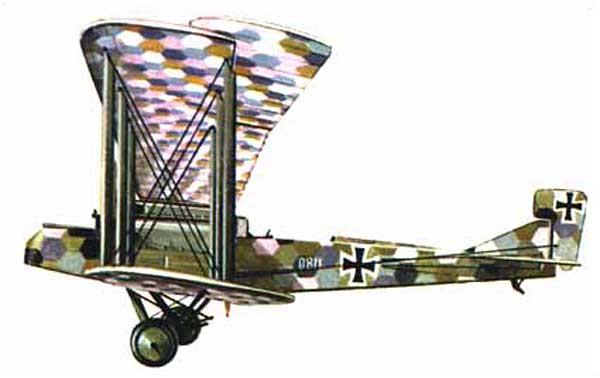

Gotha Bomber - $$8.50
Entering service in 1917.The Gotha G.V was a heavy bomber used by the Luftstreitkräfte (Imperial German Air Service) during World War I to terrorize the innocent London dweller. They carried but 1200 lbs of bombs and, in reality, more were destroyed during landing than by Allied firepower. This model is being totally re-designed (Apr 6, 09)
Gotha G.V WWI German Bomb Dropper
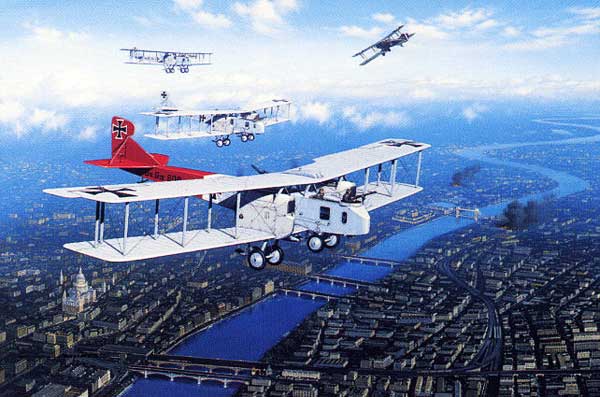
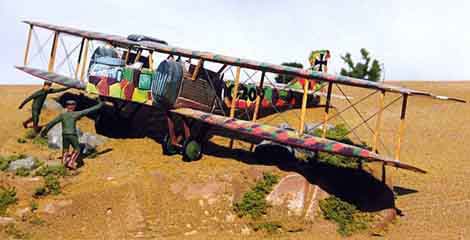
It was not until the early spring of 1917 that a long-range bomber of sufficiently advanced design and number was available to the Germans to bomb London.
With it's sinister 'lozenge' camouflage, crew of three, and 6x200lb bombs careening in at 81 mph this two engine flying nightmare made the Zeppelin bomb droppers look like Santa Claus.
What's more, the rear gunner was able to fire down through the Gotha's fuselage at attacking (and very much surprised!) allied Scouts. Whatamodel!!
Gotha G.V German WWI Bomber
Since the occupation of the Belgian coast in 1914, it had been the German ambition to be able to bomb England particularly London. But it was not until the early spring of 1917 that a long-range bomber of sufficiently advanced design was available. This flying nightmare, soon to become a household word in England, was the Gotha Bomb Dropper.
The Gotha Bomb Dropper was produced in the autumn of 1916 when the limitations of the Zeppelin as a raider had become painfully obvious. Unlike the Zeppelins, the Gotha's could fly in formation and cover each other with their Parabellum MG14 7.9 mm caliber machine guns. The German High Command decreed that 30 Gotha bombers were to be ready for a daylight raid on London on February 1st, 1917, but the machines were not actually available until May, and the first daylight raid on London was carried out by a formation of 14 Gotha's on June 13th, 1917.
This raid, and the others which followed, received little opposition and the public indignation was substantial. After July 7th, when 22 Gotha's raided the Capitol, the daylight raids on London stopped, and the following month night raids commenced. Hit and run raids continued by day in other parts of England for several weeks. Night raids continued until May 1918 and were abandoned in view of the increasingly heavy toll taken by the defenses which by that time included an efficient system of balloon-cables and many night-flying Sopwith Camels and other fighters. At peak employment, in April 1918, 36 G.Vs were in service.
On daylight attacks the Gotha's flew between 10,000 ft and 16,000 ft- too high to enable the defense to intercept them as they flew up the Thames estuary towards London. On the night raids, when a lower ceiling sufficed, a greater weight of bombs could be carried.
The most novel feature of the Gotha, and one which made it difficult to attack, was the carefully designed tunnel through the fuselage for firing downward, covering the standard blind spot and enabling the tail and underside to be perfectly protected against attacking aeroplanes. A crew of three was normally carried in the Gotha. The raids on England were mostly carried out from bases at St. Denis Westrem and Gontrode in Flanders.
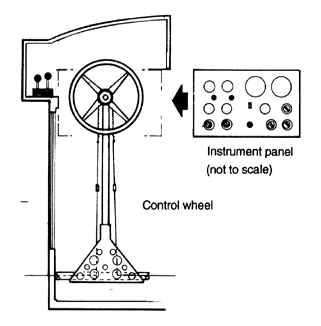
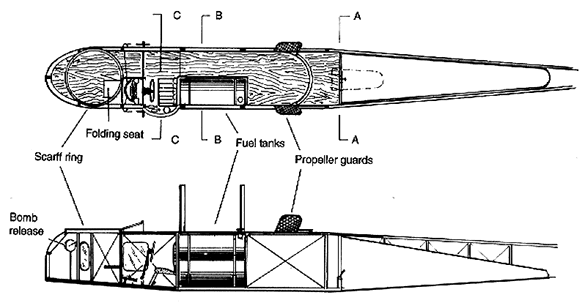
ARMAMENT: Movable Parabellum 7.9mm machine gun on turntable mounting in front cockpit and a Parabellum gun on traverse mounting on rear cockpit. (Interesting note is that this rear cockpit gun could be fired downward through an opening in the upper fuselage for belly defense). Twelve (10?) heavy Explosive (H.E.) bombs carried in twin chambers mounted within the fuselage between the pilot's and rear cockpit along with two external bombs in spring jaws under the forward section to correct tail heaviness. Some Gotha's were seen to be carrying 6X50kg bombs externally between the landing gear. Total bomb capacity was 1,102 lb.
Jane's Fighting Aircraft of WWI explains ..
"The bomb dropping instruments carry 14 bombs in all. One
in the front of the fuselage, an affair with spring jaws, contains
two bombs lying longitudinally.
Two others placed between the pilot and the rear passenger contains up to six bombs each, piled one upon the other in a rectangular chamber, so arranged that as the lowest bomb is released, it is followed successfully by the other bombs."
POWER PLANTS:
Two 260 hp Mercedes motors driving pusher props:
.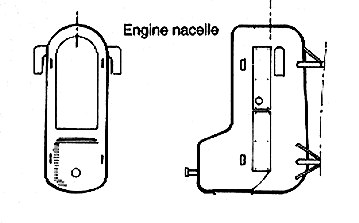
Final versions in service were the G.Va distinguishable from the G.V by the biplane tail assembly and shorter nose; And the G.Vb which sported a nose wheel for safer landings. Going into production in March 1918- in service by June, they were agile for their size, well defended, and difficult to shot down.
In all, there were 57 airship raids (564 killed and 1,370 wounded), and 27 aircraft raids (835 killed and 1,990 wounded) on Great Britain in the First World War. A total of 9,000 bombs (280 tons)was dropped. Damage totaling £3,000,000 was caused but the wasted time of workers having to take shelter had a far greater impact. Combined with this was the emotional shock resulting from raids such as that of January 28, 1918, when an exploding bomb caused a press to fall through the floor of O'dhams printing works on to people sheltering below, killing 38 of them and wounding 85 more.
The first Grossflugzeug (large aeroplane) built by the Gothaer Waggonfabrik AG was the 0.!, evolved by Oskar Ursinus and Major Friedel of the German Army from a prototype flown for the first time in January 1915. A few of these were built by Gotha under licence, in simplified and improved form. They were intended for ground-attack and general tactical duties and were employed on the Western and Eastern Fronts. The G.Is were characterized by a slim fuselage attached to the upper wings, while the two l60hp Mercedes D.III engines were mounted close together on the lower wings. Although following the same basic concept, the Gotha 0.11 was an entirely new design, evolved at Gotha under the Swiss engineer Hans Burkhard and flown for the first time in March 1916. The fuselage and engines (220hp Mercedes D.IVs) were mounted conventionally on the lower wings; overall span was increased, and auxiliary front wheels were added to the landing gear to avoid the risk of nosing over. The Gotha 0.11 carried a crew of three and a defensive armament of two machine-guns; the first production example was completed in April 1916. The 0.11 entered service in the autumn, but was soon withdrawn from operations (on the Balkan Front) after repeated failures of the engine crankshafts. It was replaced from October 1916 on the Balkan and Western Fronts by the 0.111, a new model with reinforced fuselage, an extra machine-gun and 260hp Mercedes DJVa engines. An initial 'twenty-five GIlls were ordered, and in December 1916 fourteen were in service at the Front.
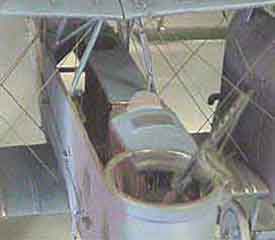 |
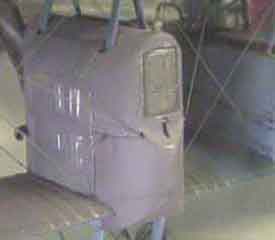 |
First major production model was the OW, chosen to carry out raids on the United Kingdom: an initial fifty G.IVs were ordered from Gotha, eighty were built by Siemens & Huckert and about a hundred by LVG. The CIV went into service about March 1917, and began to make daylight raids on southern England towards the end of May. The G.IV retained the Mercedes D.IVa, but differed appreciably in having a tunnel hollowed out of the rear fuselage so that the rear gunner could cover the blind spot' below and to the rear of the bomber. Normandy this was done with the standard rear-mounted gun, but a fourth gun could be carried for the purpose at the expense of part of the bomb load. The CIV, with an an-plywood fuselage, and ailerons on top and bottom wings, was stronger yet easier to fly than its predecessors, though its performance remained much the same as for the 0111, and Germany was obliged to switch it to night attacks against Britain from September 1917. By this time it was beginning to be replaced by the new G.V, which had entered service in August; this version continued the night bombing of England until the following May.
At the peak of their employment, in April 1918, thirty-six Gotha G.Vs were in service. Their typical bomb load on cross-Channel raids was six 50kg (1 bIb) bombs - about half their maximum load. These differed from one another only in internal details, but could be distinguished from the G.V by their biplane tail assembly and shorter nose. The G.Va/Vb went into production in March 1918 and into service in June; by August there were twenty-one G.Vbs at the Front. In general, the Gotha bombers were agile for their size, well defended and difficult to shoot down. More were lost to anti-aircraft flue than in aerial fighting, but far more still were lost in landing accidents. Forty of the Siemens-built G.lVs were completed as trainers. About thirty of the 1MG G.IVs were later transferred to Austro-Hungary, where they were refitted with 230hp Hieros and employed on the Italian Front. A seaplane development of the G.I, the Gotha-Ursinus UWD, was completed late in 1915. It was handed over to the German Navy in January 1916 and used on operations.
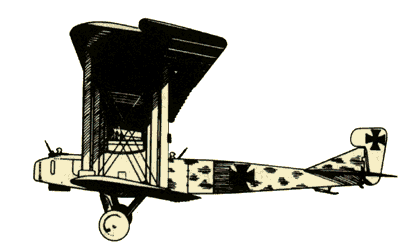
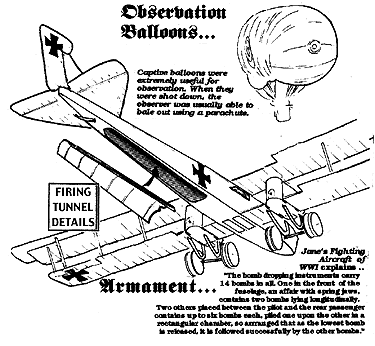
Specifications for the Gotha G.V Bomber
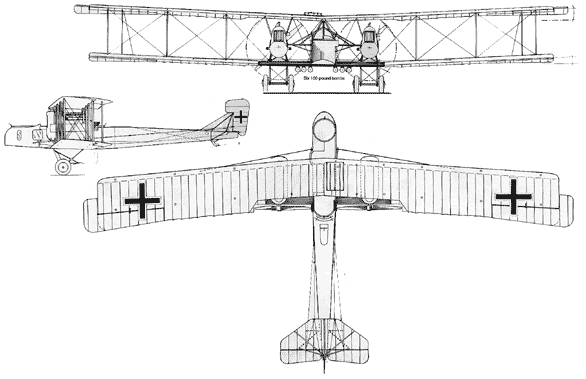 |
Crew: 3 Length: 40 ft 8 in Wingspan: 77 ft 9 in Height: 14 ft Wing area: 963.6 ft² Empty weight: 6,039 lb Max takeoff weight: 8,745 lb Powerplant: 2× Mercedes D.IVa inline engine, 260 hp each Performance Maximum speed: 87 mph Range: 522 miles Service ceiling: 21,325 ft Armament 2 or 3 × 7.92 mm (.312 in) Parabellum MG14 machine guns |
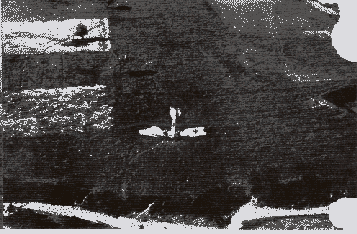
The Gotha was more deadly to itself than to the Allies



